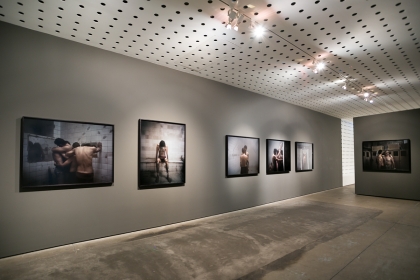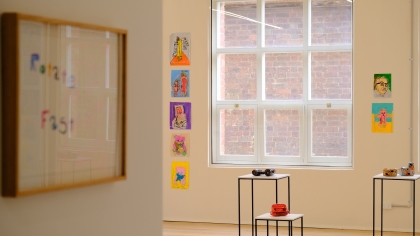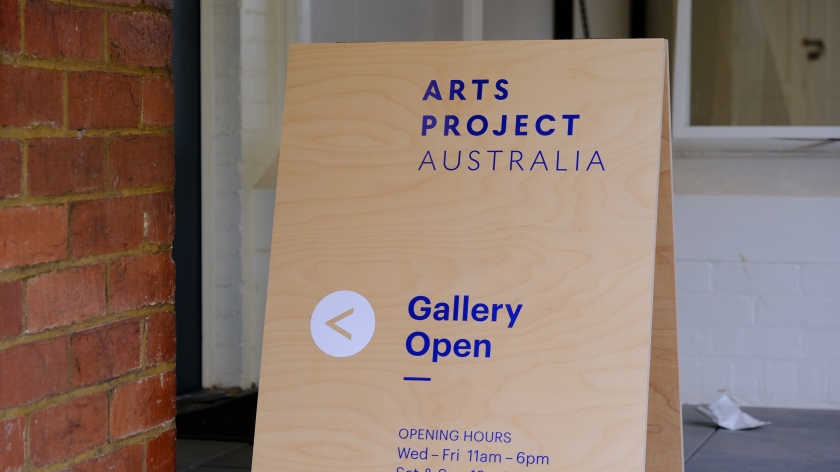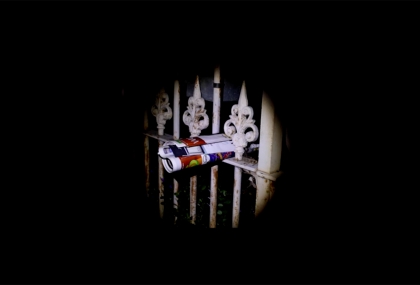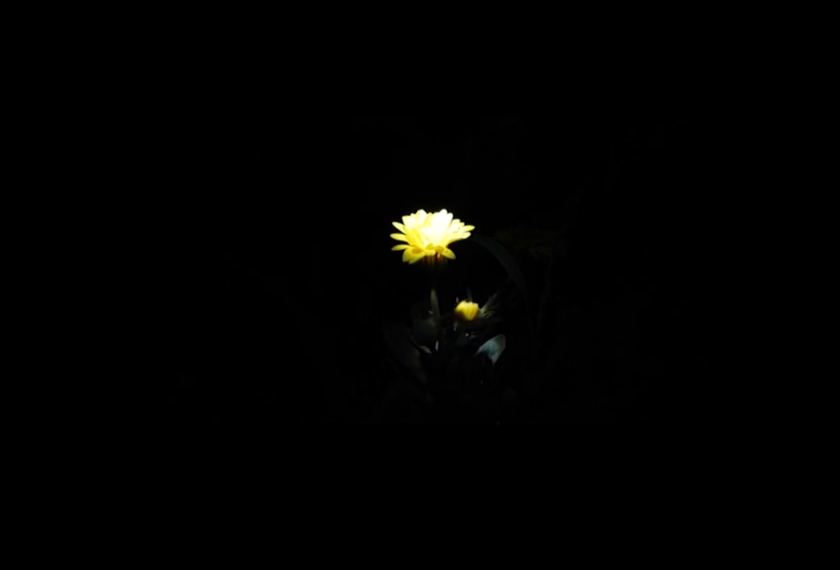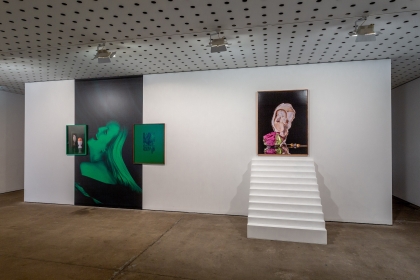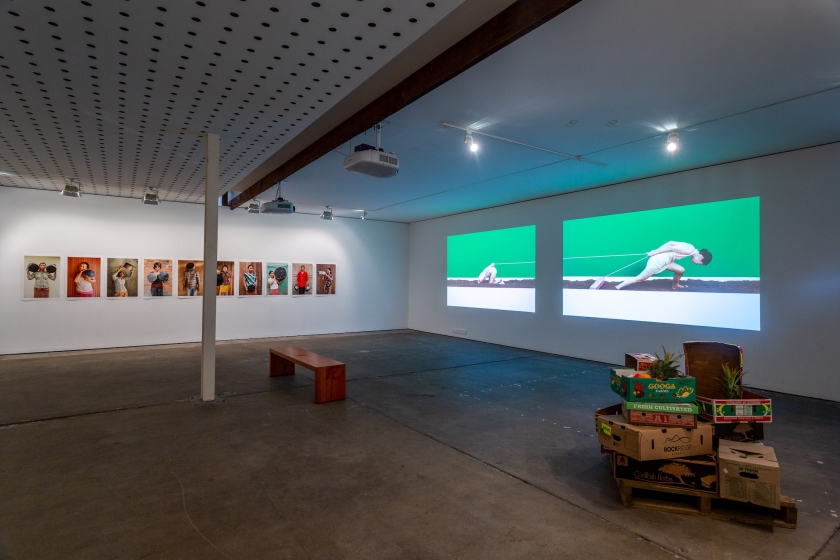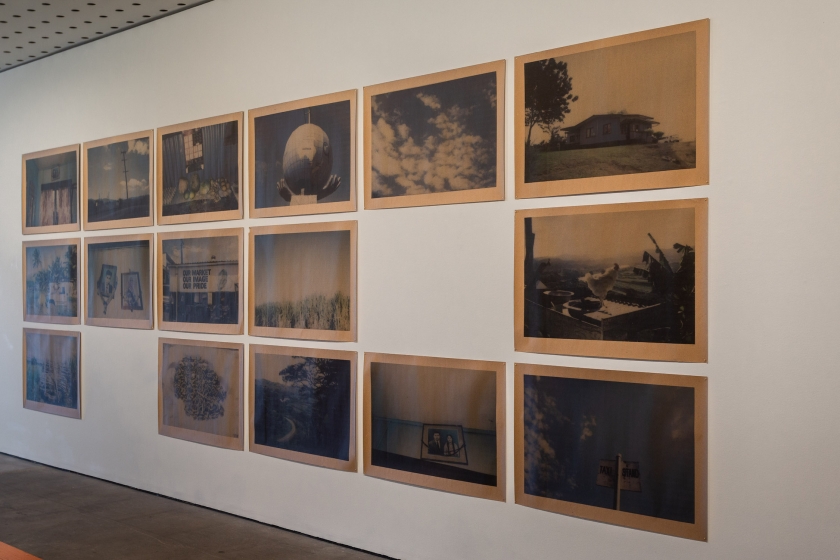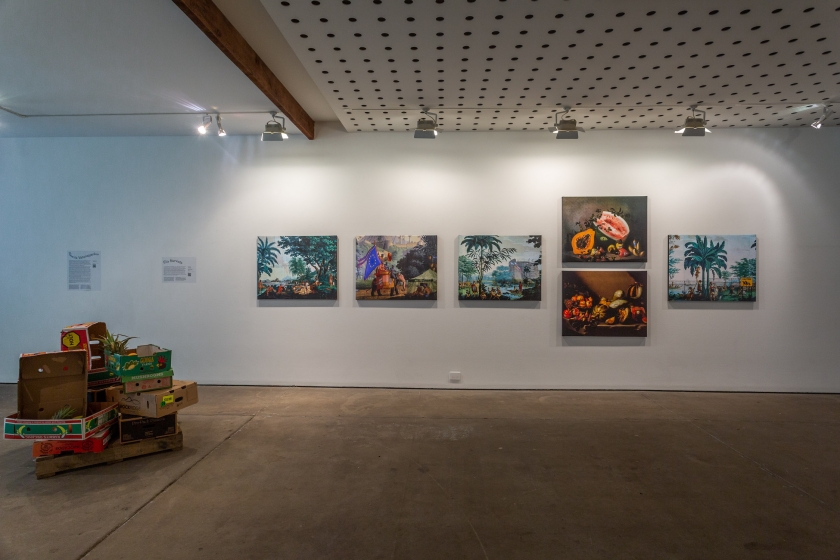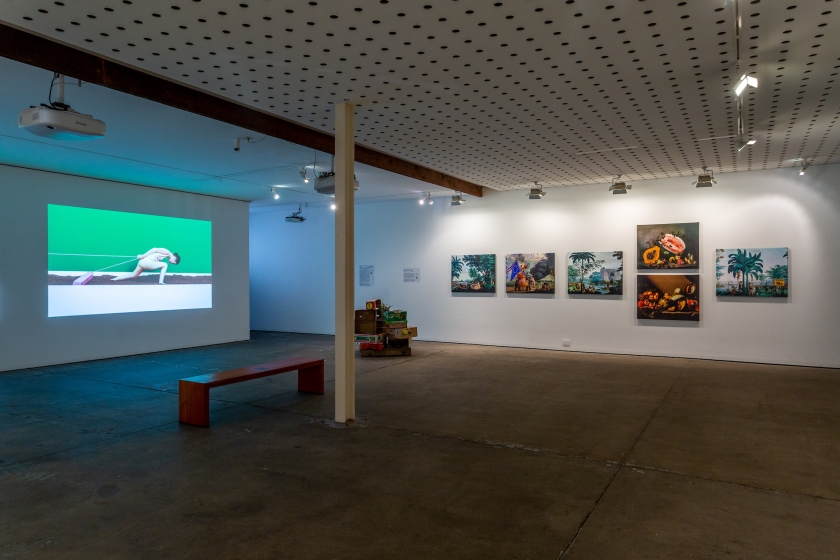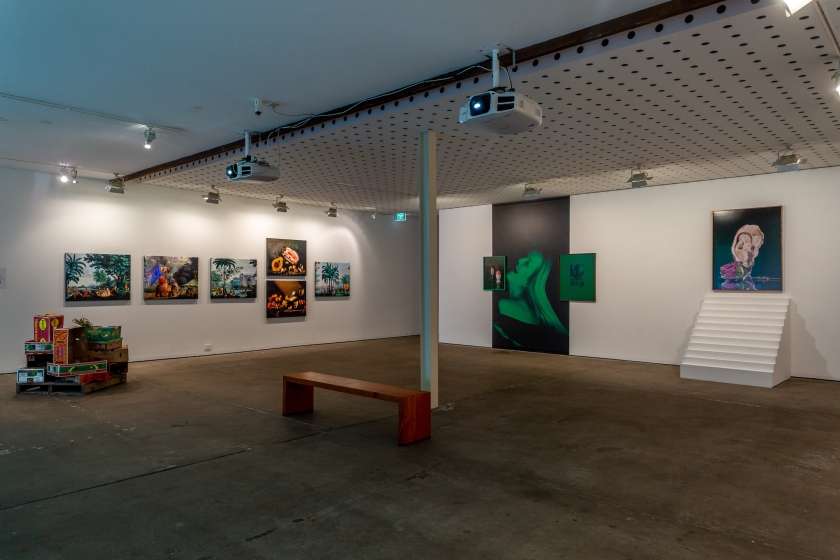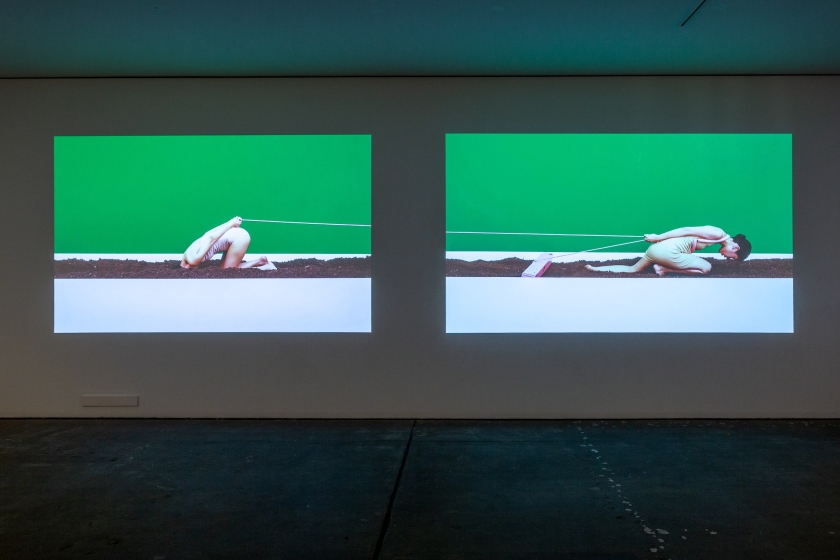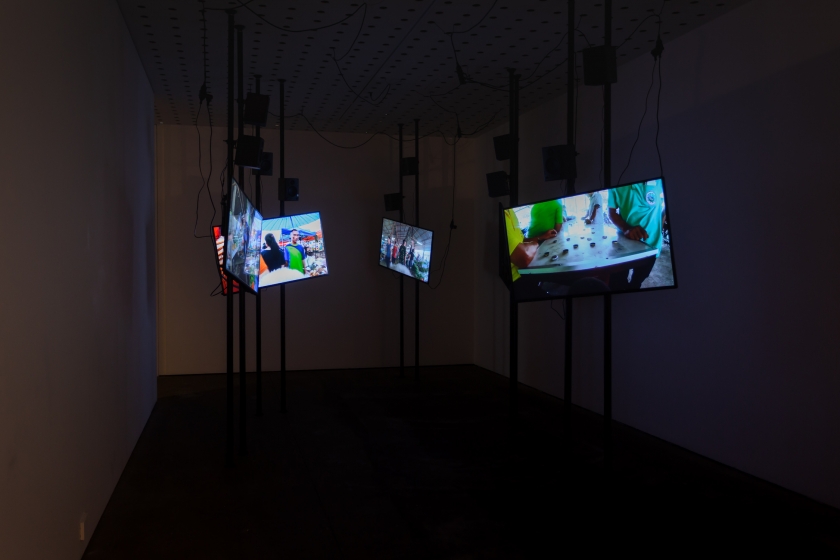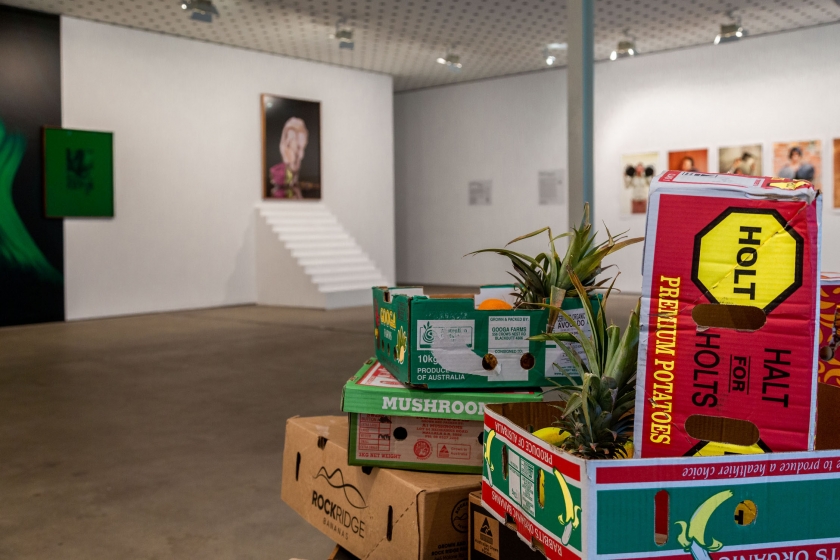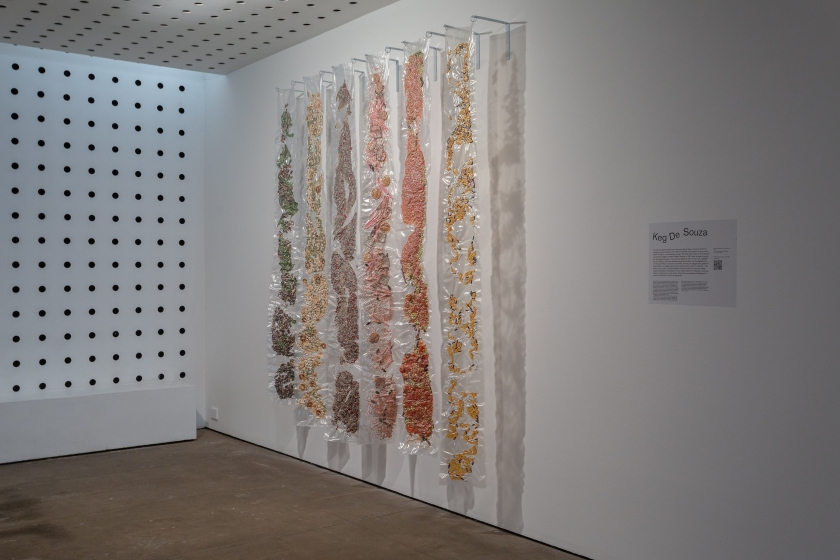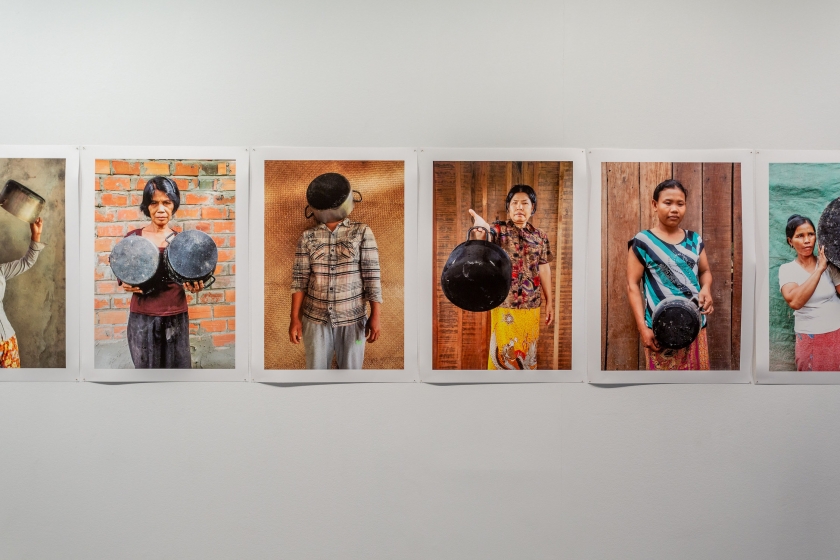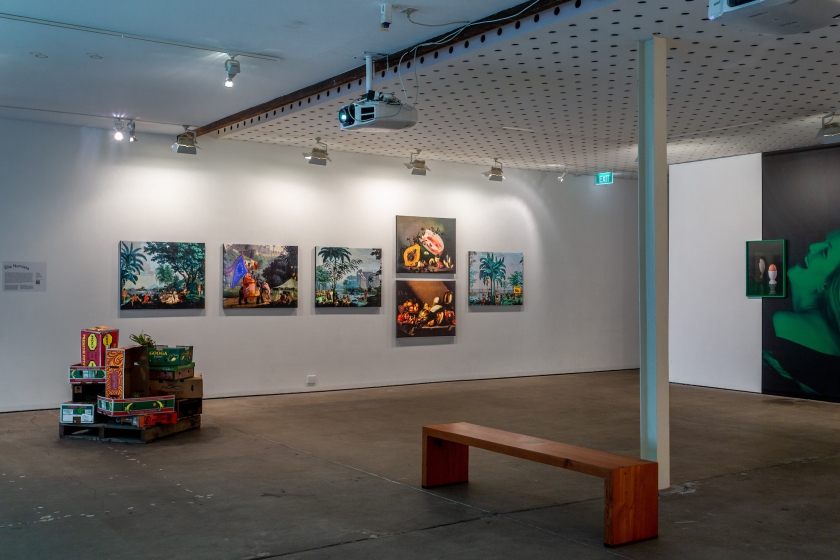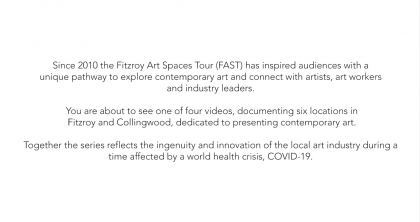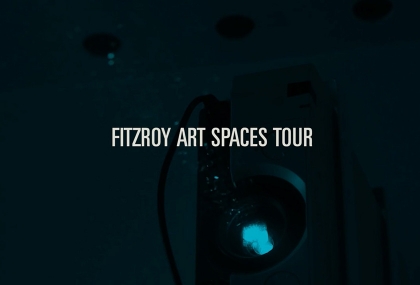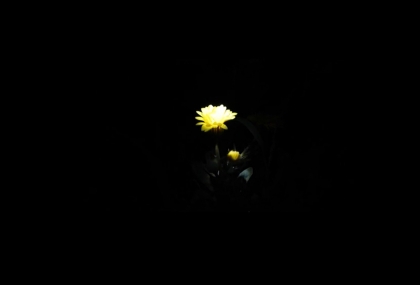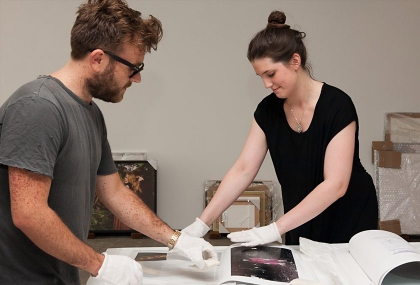Fitzroy Art Spaces Tour (FAST) is an education program for teachers and students of VCE Studio Arts. The program offers a unique pathway to explore the contemporary art industry within a renowned local art precinct. There are two aspects to FAST; one is on foot – the FAST walking tour, while the other is online.
FAST enables students to engage with professionals behind the scenes at our participating partner organisations:
- Arts Project
- Centre for Contemporary Photography (CCP)
- Gertrude Glasshouse
- Daine Singer
Participants experience various approaches to the exhibition and promotion of contemporary art and explore curatorial considerations involved in the display of artworks.
FAST has been developed in consultation with the Victorian Curriculum and Assessment Authority (VCAA) with support from the Department of Education and Training (DET) through its Strategic Partnerships Program (SPP).
Each FAST partner organisations is committed to safety and wellbeing of all young people and all have a zero tolerance for child abuse. The FAST program is guided by a VIT registered teacher.
A program of FAST walking tours are scheduled regularly on Fridays throughout May-September during the school year.
The 2021 FAST walking tour program is now fully booked. To join the wait list and for all enquiries please email education@ccp.org.au
Fitzroy is an inner-city suburb that has been gentrified over recent decades, with manufacturing and warehouse sites transformed into studios, galleries and apartments. Brunswick, Johnston and Gertrude Streets are popular shopping strips lined with designer specialty shops, cafés, bars and restaurants.
Fitzroy offers a diverse cultural scene encompassing leading contemporary public galleries, commercial art galleries,artist-run spaces and studios. Each gallery in Fitzroy is unique and caters for its own particular audience.
Once you have booked your FAST tour you will receive a confirmation email from education@ccp.org.au
Full payment must be received within 21 days prior to the tour date.
The walking tour provided by FAST is $17.50 per student (no charge for teachers).
Each school that participates in the program must agree to the FAST Terms and Conditions prior to the commencement of the program. To download Terms and Conditions, click here.
Cancellations
Program cancellations must be submitted in writing via email to education@ccp.org.au
Cancellations more than 14 days prior to the tour date will incur a cancellation fee of 50%.
No refunds will be issued for cancellations less than 14 days prior to the tour date.
Rescheduling
Requests to reschedule a tour will be accommodated subject to availability. Email education@ccp.org.au at least 21 days prior to the program.
Where and when
FAST walking tours commence at CCP, 404 George Street, Fitzroy, at 10am and finish at Gertrude Glasshouse, 44 Glasshouse Rd, Collingwood at 2.30pm.
Transport
CCP is 100 metres from Smith Street (tram no. 86), 200 metres from Brunswick Street (tram no. 11) and 100 metres from Johnston Street (bus nos. 200, 201, 203, 205 or 207).
For more information, visit the Vic Trip website: www.ptv.vic.gov.au/journey
The City of Yarra Council offers in-kind support through a free community bus for outer-metropolitan and regional schools. If you are interested in accessing this service, please contact the CCP.
Parking
There is limited, short-term parking available in Fitzroy.
What to wear
FAST is a full day walking tour so it is requested that all participants wear comfortable shoes and clothing suitable for staying outdoors for an extended period of time. All participants are required to be able to walk approximately three kilometres throughout the day.
What to bring
Please bring an umbrella, lunch, water bottle, pen and paper for taking notes, a smartphone or camera to document the exhibitions (please note: no flash allowed in the galleries).
Food and drink
Participating teachers and students are required to bring lunch and a water bottle. There will be one supervised lunch break during the program with a sheltered venue available in case of rain. There is not enough time to visit cafés during the program.
For further enquiries about FAST walking tours, contact CCP Education Consultant Melissa Bedford.
Email: education@ccp.org.au
Phone: 03 9417 1549
The Fitzroy Art Spaces Tour (FAST) is an educational guided tour of four Fitzroy art galleries, representing a microcosm of the contemporary visual arts industry.
You can find out about each organisation by visiting their website, listed below each profile.
-
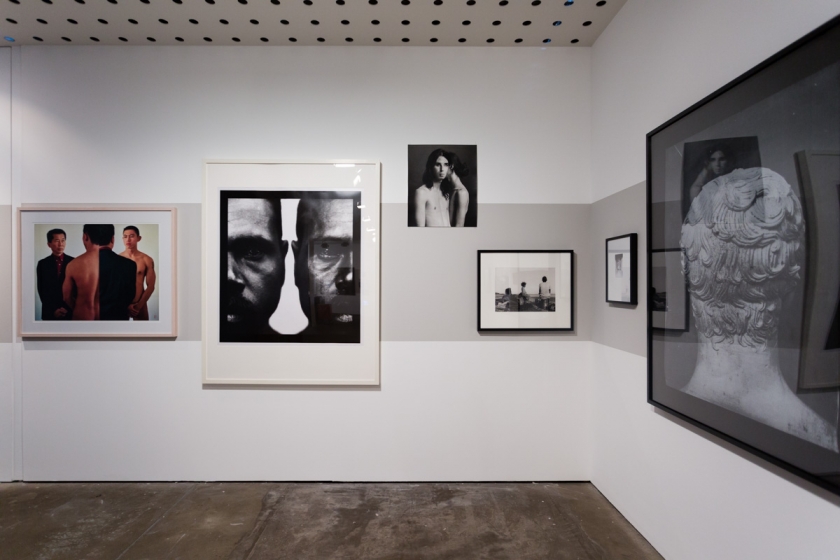
An unorthodox flow of images, 30 September—12 November 2017, Centre for Contemporary Photography. Part of the Melbourne Festival. Photo: J Forsyth
-

Hoda Afshar: Behold, 4 August—17 September 2017, Centre for Contemporary Photography. Photo: J Forsyth
-

The Art of Publishing: An Exhibition of MACK Books, 6—21 January 2018, Centre for Contemporary Photography.
CCP is a public gallery that was established by the photographic community in 1986. Exhibitions feature photography and video from emerging to established artists. The program includes individual, group and curated exhibitions, featuring photomedia by local, interstate and international artists. CCP has five exhibition spaces: four internal galleries and the Night Projection Window, viewed from the street after dark.
404 George Street, Fitzroy VIC 3065
T 03 9417 1549
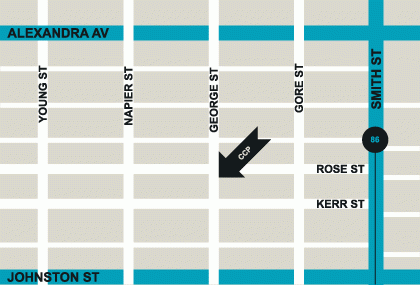
CCP – A Public Gallery
The Centre for Contemporary Photography (CCP) is a publically funded organisation that presents a regular and varied program of exhibitions to the general public.
As a not-for-profit organisation, CCP is eligible to receive a portion of its funding from government. However, it needs to generate revenue through other avenues such as ticketed public and education programs, fundraising, bookshop sales, philanthropy, sponsorship and partnerships with the private sector, and through artwork sales. Any profits generated by not-for-profit galleries are reinvested into their future programs.
Artists who exhibit at not-for-profit public galleries do so in two main ways; by invitation and application. Public galleries endeavour to pay artists a minimal ‘artist’s loan fee’.
CCP pays between $300 and $1200 to each exhibiting artist depending on the scale of the exhibition space. Public galleries also commission artists from time to time to make new work and need to secure a commission fee for the artist. For more information about fee structures, visit the National Association of Visual Arts (NAVA) website.
A third way for an artist to exhibit at CCP is through the open-entry exhibition known as Salon. This popular annual exhibition offers a unique opportunity for hundreds of members of the photographic community to show their work.
For more information about public galleries, visit the Public Galleries Association of Victoria (PGAV) website. You can also visit Victoria’s largest public art gallery, the National Gallery of Victoria (NGV).
Arts Project Australia
https://www.artsproject.org.au
First floor, Collingwood Yards, 35 Johnston St, Collingwood
0477211699
Established in 1974, Arts Project Australia is a creative social enterprise that supports artists with intellectual disabilities, promotes their work and advocates for their inclusion in contemporary art practice. Artists involved in the studio program practice their art at the APA studio in Northcote or online. The gallery was based at the Northcote building alongside the studio from 2002 until it moved to Collingwood Yards in 2021, further expanding the reach of APA artists’ work.
- Arts Project Australia is a medium sized not-for-profit public gallery supported by a highly qualified team of board, staff and volunteers who support, promote and advocate for the artists.
APA operates as a supported studio, which is a creative environment that supports the practice of artists with specific health or social needs, and was the first full-time art studio in Australia for artists with an intellectual disability. The APA gallery supports the studio by consistently producing and delivering quality internal group and solo exhibitions as well as brokering extraordinary national and global external exhibitions, art prizes, and awards for APA’s 170 emerging, mid-career and established artists.
APA artists exhibit at least once a year, with an Annual Gala showcasing a piece from each artist produced during that calendar year. Twice a year, external curators work with to produce an exhibition including selected APA artists shown alongside other invited external contemporary artists.
APA is a social enterprise, which is an organisation that uses commercial strategies for social benefit often funded by reinvesting profits back into the organisation to meet community improvement goals. For instance, at APA, for each sale of artwork, 60% of the sale goes to artists while 40% goes back to the APA to support all artists as well as the organisation. APA also receives in-kind or financial income from a variety of streams, including from partnerships with Leonard Joel, Limb Family Foundation, Art Guide, NDIS, private donations, artwork sales, and government grants.
Arts Project Australia’s studio is currently open to artists and staff in Northcote, while the gallery in Collingwood is open to visitors each Tuesday-Sunday.
-
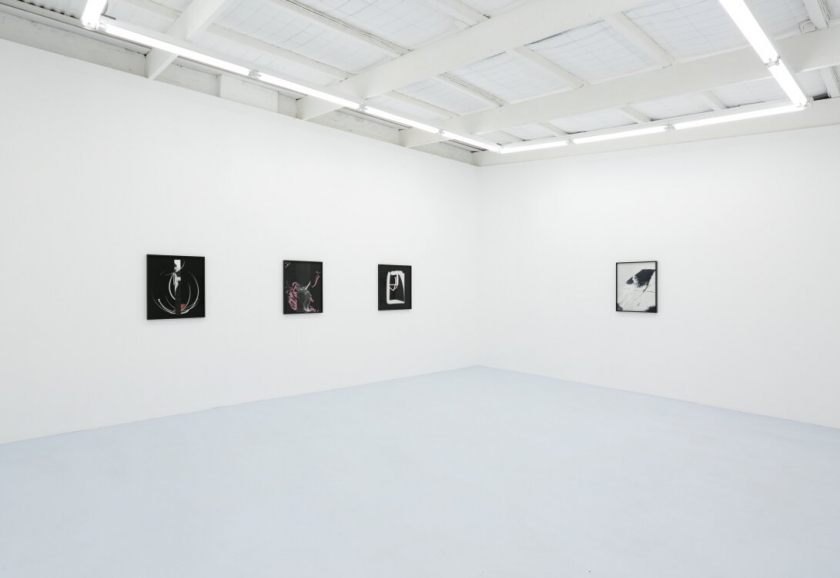
Zoe Croggon, Pale horse, pale rider (2020). Photograph: Tim Gresham
-
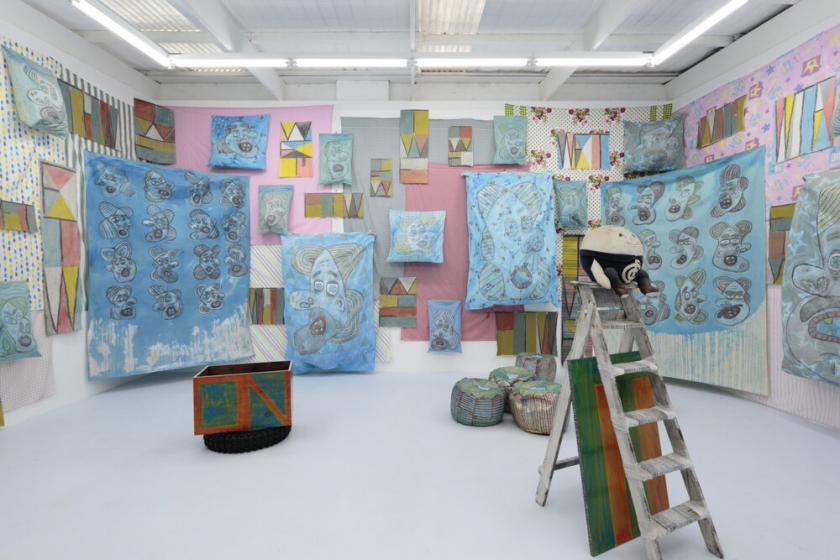
Jordan Marani, Nobody (2020). Photograph: Tim Gresham
Daine Singer
Daine Singer is a Fitzroy-based commercial gallery exhibiting contemporary art. The gallery exclusively represents a group of fifteen artists from Australia and New Zealand. The dynamic gallery program includes solo exhibitions by represented artists as well as projects by unrepresented artists and occasional curated exhibitions.
Daine Singer is a commercial gallery exhibiting contemporary art. The gallery was established in 2011 in Flinders Lane, Melbourne, and relocated to Fitzroy in 2018. The gallery exclusively represents a group of fifteen artists from Australia and New Zealand. The dynamic gallery program includes solo exhibitions by represented artists as well as projects by unrepresented artists and occasional curated exhibitions. The gallery is committed to ethical dealing and fully supporting its artists. It limits representation to a small number of artists, each with distinctive practices. While the gallery is multigenerational, it is particularly known for establishing the careers of young artists, as the first gallery to represent them. As an adjunct to the exhibition program, the gallery recognises the importance of arts writing by accompanying exhibitions with new writing, and has also published four limited edition artist books through its independent small press, VERSION: Lane Cormick NOHARDATTACK, Jordan Marani EGGS, Kate Moss Wild Thoughts and Peter Davidson Words/ Lines.
-

Shelley Lasica, The Design Plot, 2017, performance shot at Gertrude Glasshouse.
-
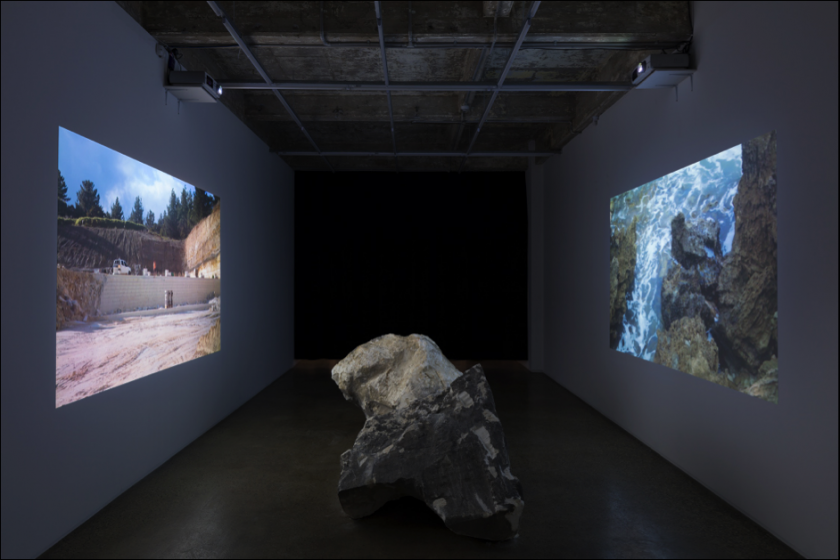
Noriko Nakamura, Erosion, 2017, Installation shot at Gertrude Glasshouse. Image Matthew Stanton.
-

Josey Kidd- Crowe, …the thought an oyster has…, 2017, installation shot at Gertrude Glasshouse. Image: Christo Crocker
Gertrude Glasshouse
44 Glasshouse Rd, Collingwood VIC 3066
P: 03 9419 3406
W: http://gertrude.org.au
Open Thursday – Saturday 12pm – 5pm.
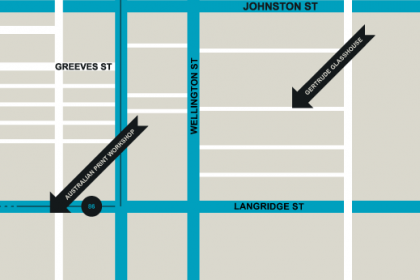
Gertrude Glasshouse - Gertrude Contemporary’s satellite exhibition space
Gertrude has been building the careers of Australia’s artists for over 30 years. Since our establishment in 1985, Gertrude has played an essential role in the visual arts sector, shaping the careers for many of Australia’s most celebrated artists.
We are an incubator and launching pad for contemporary artists. Our artistic program – including our studio and exhibition program – is unique in its equal emphasis on the production and presentation of contemporary art. This enables us to support artists to explore new ideas and present risk-taking work at pivotal points in their careers. Gertrude's alumni distinguish themselves in major Australian and international exhibitions and collections, for example, 17 of the 20 artists representing Australia at the Venice Biennale since 1995 have been Gertrude Studio or exhibiting artists.
Gertrude gives audiences unique insight into the creative development of artists. Our audiences engage with risk-taking, formative moments that define artist careers. Gertrude also gives teachers and students of all ages inspiring learning experiences in the public presentation and behind-the-scenes production of art through engaging curriculum-aligned educational programming.
Gertrude manages two sites: Our main premises at 21-31 High Street in Preston South which is the home for our major exhibition program, sixteen artist studios and offices; and Gertrude Glasshouse, our satellite exhibition space in Collingwood.
Spots by Charlie Sofo
Created for the Fitzroy Art Spaces Tour
About Charlie Sofo
Charlie Sofo is a Melbourne-based artist who works across a range of mediums – sculpture, video, drawing and performance. His practice often explores the details of daily life. For this project, the artist was commissioned to create a short video work about FAST. Walking through the streets of Fitzroy, around the FAST galleries, Sofo bought together an array of ordinary and extraordinary objects to give them a new poetic meaning. Taken on his mobile phone this work explores our neighbourhood at night in a poetic and playful manner, reminiscent of old movies. http://charliesofo.blogspot.com.au/
Learning activity for the classroom
See Resources section
These resources have been developed to offer VCE Studio Arts students and their teachers real-life insights into the ways art industry professionals collaborate with contemporary artists at CCP to prepare for and present exhibitions.
An aspiring artist who intends to exhibit their work publicly will engage with the art industry at various stages as their career evolves.
Every exhibition of a living artist’s work is the result of a considered process undertaken by artists and art industry professionals who work with them to bring their artwork into the public sphere.
FAST’s online resources for 2021 provide a behind-the-scenes look at two exhibitions staged at the Centre for Contemporary Photography, and an exhibition staged by commercial gallery Daine Singer. Examining exhibition-making in relation to group shows and solo retrospectives across commercial and publicly funded galleries, FAST resources are designed to support and engage with VCE Studio Arts curricula.
To accompany Fertile Ground, a group show addressing the politics and social impact of food culture, artists speak from their studios about their practice and involvement in the arts. To further students’ understanding of art industry contexts we provide a recording of CCP Educator Melissa Bedford undertaking a virtual FAST tour of CCP with CCP Acting Curator Shae Nagorcka. To enhance this experience, a full suite of installation images are provided with a video fly-through of the installed exhibition. To allow greater understanding of the political themes of the exhibition, students can download a responsive essay by Dr. Jen Rae.
To further students’ understanding of art industry contexts, FAST and Daine Singer present a case study that looks at the operation of a commercial gallery. Kirsty Budge’s If you’re gonna spew, spew into this, is accompanied by a Q&A with Gallery Director Daine Singer as well the exhibition room sheet, essay and artwork documentation images.
As an additional case study for VCE Studio Arts, FAST presents a virtual tour of Ruth Maddison: It was the best of times, it was the worst of times. Guided by Ruth Maddison and CCP Director Adam Harding, students are taken through the process of organising and constructing a historic survey exhibition.
Fertile Ground
Lauren Dunn, Kim Hak, Shivanjani Lal, Sophal Neak, Arnont Nongyao, Elia Nurvista, Keg De Souza, James Tylor, Kawita Vatanajyankur
21 July – 05 September 2021
Fertile Ground brings together nine artists who use food as an entry point to discuss urgent political, societal and environmental issues. The artists offer food as a tool for activism, cultural exchange, repositories of history and visions for the future.
Physical, cultural and ideological ramifications of food production, circulation and consumption are examined by artists Elia Nurvista and Lauren Dunn. Nurvista focuses on the impact of colonial power and exploitation on food farming, production and marketing. Produce and customs are commodified and sold as exotic, luxury items or experiences with total disregard for their native countries, communities and farming conditions. Dunn too highlights this in her series ‘New Romanticism’ where she draws attention to societal romanticised relationships with food and food culture. In the installation Luxury item no.13 she physically places the oyster as a prized possession elevated upon a quasi-throne to emphasise idealised food hierarchies and structures.
The works by James Tylor and Keg de Souza continue interrogating colonial impact on Indigenous food sources and scarcity, highlighting the historical and contemporary inability to recognise and value indigenous farming and traditional practices in caring for native ecosystems. Tylor presents recipe cards informed by indigenous and non-indigenous ingredients, inviting visitors to take away the recipe and consider investigating, cultivating and cooking with native and introduced ingredients to decolonise their pre-existing relationship with food. De Souza’s practice focuses on scrutinising community food, space and displacement. In the work The earth affords them no food at all specimens of indigenous ingredients, imported crops and food samples from the many waves of migration work as a record of displaced, diasporic and frontier food narratives within Australian history and culture.
Fertile ground accepts any and everything that is planted but, with disruption and lack of nourishment, the reality of failure and loss is inevitable. Kim Hak, Shivanjani Lal and Sophal Neak investigate the fragility of existence and create repositories for memories. They explore landscapes as shifting sites, lament the loss of ancestral land and question the temporality of place. As an ancestral survivor of the Khmer Rouge regime, Kim reflects upon the cycles of life and relationship to his father and the land in his ‘Sunset’ series, and Lal on her familial history and relationship between lands (India and Fiji) in her ‘Chaapaa’ series. Shivanjani shares a series of images that are enlarged polaroids, reminiscent of a family travel album, reprinted in India onto brown paper and documenting a contemporary and changing Fiji. As Lal highlights forgotten pasts, artist Neak also gives voice to those who cannot speak for themselves in her project ‘Rice Pot’. Neak, a performative photographer driven by storytelling, explores societal pressures, traditions and responsibilities of women to nourish the community. Her photographs are the result of ongoing conversations with women from her ancestral village who found a collective voice in Neak’s visits and community workshops.
Kawita Vatanajyankur and Arnont Nongyao explore the systems of trade and farming practice. In her ‘Field Work’ series, Vatanajyankur appears silent in her physical transformation from woman to essential farm machinery who prepares the ground for harvest. Her rhythmic and robotic pattern appears endless and pointless. As Vatanajyankur engages in the act of production, Nongyao celebrates the results in screen and sound work, Opera of the Kard. An immersive operatic soundscape shares the ‘vibration’ of community at a local kard (market) with layered voices of the farmers selling their produce.
Interrogated through the mediums of photography, video, sculpture and installation, the participating artists enable new perspectives and explorations in social space and thinking. Shared reflections on the uncertainty of place, the fragility and temporality of land, may raise anxieties about where we now find ourselves, while also empowering a collective consideration for a bountiful future, a fertile ground, on which to regenerate and rethink.
Take an immersive video tour through the exhibition Fertile Ground, bringing together nine artists who use food as an entry point to discuss urgent political, societal and environmental issues.
Discussion: Fertile Ground
FAST's Melissa Bedford discusses the exhibition 'Fertile Ground' with CCP Acting Curator Shae Nagorcka.
0:00 - 2:00: Introduction
2:00 - 3:25: What type of gallery is CCP and what role does it play in the art industry?
3:25 - 9:00: How do artists come to exhibit at CCP?
9:00 - 14:20: Could you please discuss the role of a curator, and then how and why Sarah and Olivia have curated the Fertile Ground exhibition?
14:25 - 17:35: Fertile Ground introduction
Discuss 3 artists work: 1
7:35 - 20:24: Neak Sophal
20:25 - 23:15: Kawita Vatanajyankur
23:20 - 27:02: James Tylor
Discuss presentation methods:
27:10 - 32:06: Arnont Nongyao
32:10 - 39:30: Exhibition design
39:45 - 49:30: Conservation and handling
49:57 - 1:01:30: Marketing and promotion
In Fertile Ground, Elia Nurvista presents the project Früchtlinge, which consists of two words in German: Früchte means 'fruits', and Flüchtling meaning 'refugee'. It's a humorous but also critical reflection on the Western approach to food in today’s globalised world. With subtle irony, she exposes the paradoxical interpretations of what is “exotic” and foreign.
Mai: Kaurna Contemporary Food is a food based art project about Kaurna food, history and culture. This project explores developing a new Kaurna cuisine called 'Mai' using indigenous and non indigenous foods to tell our rich and unique history within Australia. In Fertile Ground, James Tylor invites visitors to take away one of these recipes and consider investigating, cultivating and cooking with native and introduced ingredients to decolonise their pre-existing relationship with food.
Opera of Kard is an immersive multi-screen and sound installation, which has been fitted to CCP for its presentation in Fertile Ground. Each of the videos play the sounds and scenery from a kard, or market in northern Thailand. Rearranged into a single composition, the sounds now come together as a social-cultural operatic performance of the kard. Here, Arnont Nongyao talks us through Opera of Kard — an immersive operatic soundscape that shares the ‘vibration’ of community at a local market.
The Spade (2020) and Plough (2020) are a part of Kawita Vatanajyankur’s new series ‘Field Work’ which explores modern industrialized agriculture based on mass production. Her ‘Field Work’ videos are visual languages of contemporary consumption and desire within a world of instant gratification. Within a laboratory-like environment, Vatanajyankur reconstructs and reimagines the futuristic settings of the industries of agriculture where human bodies are intertwined and connected with the machines that are replacing humans.
The vacuum packed food items in the earth affords them no food at all (2017) represent various narratives over time of Australian food culture from pre-colonisation through to a contemporary context. The title refers to a quote from English coloniser William Dampier in 1697 when he was surveying the Australian landscape. This quote is a departure point for the work, highlighting the inability to value the exisiting thriving food culture and the displacement of it through British colonisation of this land. The work speaks to these histories of displacement and the evolving food culture in Australia.
As an ancestral survivor of the Khmer Rouge regime, Kim Hak reflects upon the cycles of life and relationship to his father and the land in his Sunset series. Through an elegiac documentation of his father's garden, Hak considers how we return back to nature and finally, we return back to the ground, a ground that will continue to change through planting.
In New Romanticism, Lauren Dunn continues her enquiries into the politics and ethics surrounding food consumption trends and the role images play in this relationship. Through research she examines the underlying power structures hidden behind the romanticism of food specific plant and animal popular imagery. She employs the idea of photographic thinking through the material and works to twist the codes and conventions of commercial photograph, presenting a thought provoking and insightful take on the post photographic landscape.
Shivanjani Lal reflects on her familial history and relationship between lands (India and Fiji) in her Chaapaa series. Lal shares a series of images that are enlarged polaroids, reminiscent of a family travel album, reprinted in India onto brown paper and documenting a contemporary and changing Fiji as part of an ongoing archival project.
Rice pot is a multimedia project that draws our attention to the struggles and endeavors of Cambodia's women through still images, video and stories. Featuring a group of women in her hometown, a rural part of Takeo province in Cambodia, Sophal reflects and gives voice to women who work the communal kitchen stove, honouring their value and significance of their role and responsibility in providing the family’s nourishment.
Kirsty Budge: If you’re gonna spew, spew into this
18 November - 19 December 2020
Kirsty Budge’s new paintings combine deep introspection and an interest in psychoanalysis with a broader view that embraces the richness of the world. They are a complex and ambiguous mix of figuration, abstraction, personal narrative and landscape.
Budge’s painting method embraces intuition, a process that the artist describes as “the intention of painting itself and the point where you break away from what you literally see, listen to what the work is doing and follow the intuitive composition emerging within the painting.”
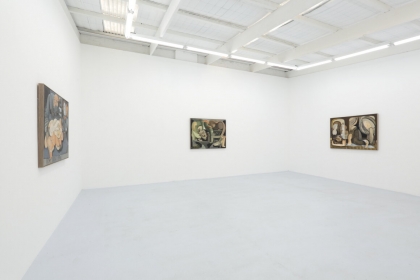
Click here to view the exhibition essay for Kirsty Budge’s If you’re gonna spew, spew into this, written by Nadia Abdulrahim.
For a comprehensive room sheet and further details about the artworks, click here.
View the exhibition on the Daine Singer website.
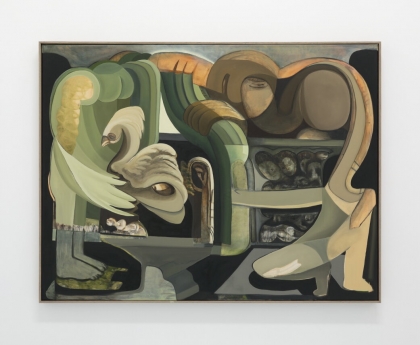
Ruth Maddison: It was the best of times, it was the worst of times
Ruth Maddison: It was the best of times, it was the worst of times is a significant survey exhibition focusing on Maddison’s social documentary practice from 1976 to the current day. Bringing together key historical works with a major new commission, this exhibition is a timely and focused look at one of Australia’s leading feminist photographers.
The exhibition features several key series, from Maddison’s earliest hand-coloured works to more recent projects documenting Eden’s people and industries illustrate the changing face of regional Australia and the societal pressures that have come to bear. These works are presented alongside Maddison’s documentation of the cultural milieu of Melbourne with a focus on the late 1970s and 1980s.
The newly commissioned work The Fellow Traveller (2020) is an immersive photographic installation exploring Maddison’s father’s radical political activities in Australia and overseas from the 1950s–1980s, which were under ASIO scrutiny.

Click here to view a virtual tour and case study of the exhibition Ruth Maddison: It was the best of times, it was the worst of times. Guided by the artist and Adam Harding (Director of CCP), the video has been produced to examine exhibition making at the CCP and support teachers and students to engage with VCE Studio Arts, Art Industry Contexts curricula.
Introduction
Four FAST perspectives in film:
Student and Teacher, Gallery Director, Curator and Artist.
Behind the scenes of Entre Nous: Claude Cahun and Clare Rae
Education Consultant: Melissa Bedford
Camera: Sherwin Akbarzadeh, Stuart Mannion and Jesse Taylor Smith
Director/Editor: Jim Arneman
Thanks to: Michelle Mountain, Heath Mckinley, Clare Rae and Asko Ryhanen
Claire & Alessia - Student and Teacher
Naomi Cass - Gallery Director
Helen Hughes - Curator
Arlo Mountford - Artist
Behind the scenes of Entre Nous: Claude Cahun and Clare Rae
Learning activity for the classroom
Inspired by Charlie Sofo's video, spots
View video here
Create your own artwork by carefully observing and recording the details of your neighbourhood or your daily journey to and from school using any lens based media. You might try different times of day or night, playing with the change in natural light. You might also choose to focus on small incidental details rather than the full scene. Select and edit your collection of images to produce a finished artwork about your experience. For instance, you may produce a time-based artwork like Charlie Sofo or you may produce a sequence of still images. Consider how to you might present your artwork in a class exhibition.
-
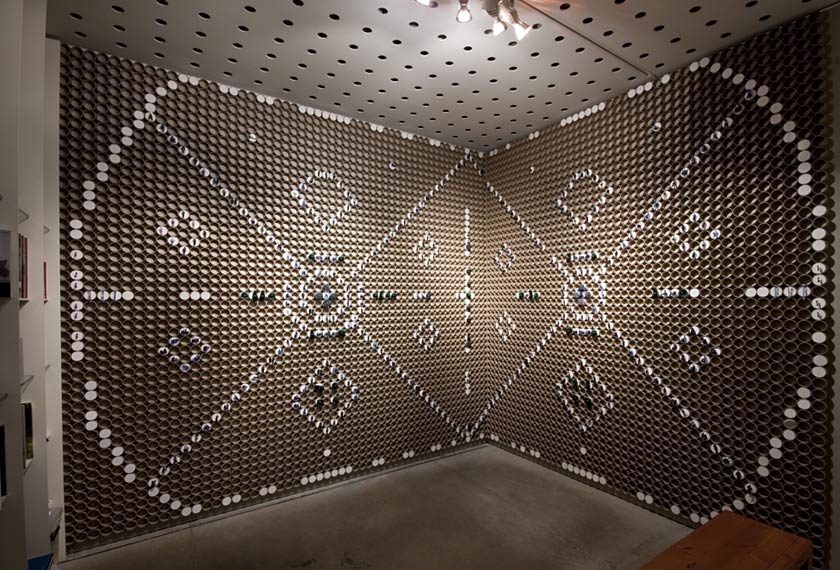
Installation view: Parklife, CCP, 2010.
-
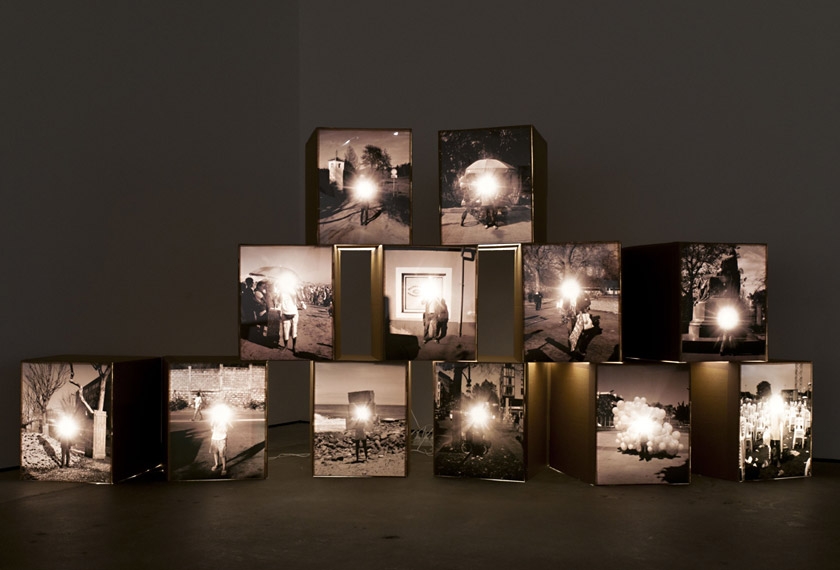
Installation view: Anonymity, CCP, 2011.
-
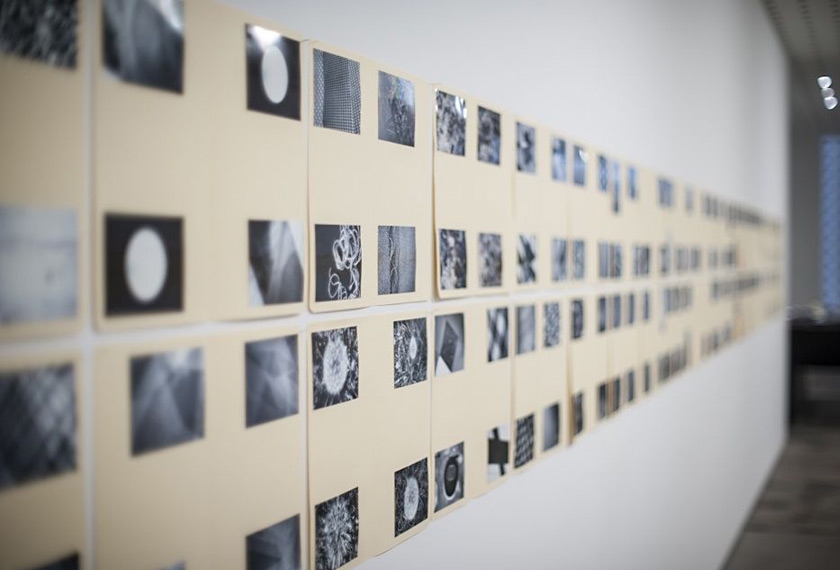
Installation view: Black White & Grey. Photographic Studies (Photosheets), CCP, 2012.
-
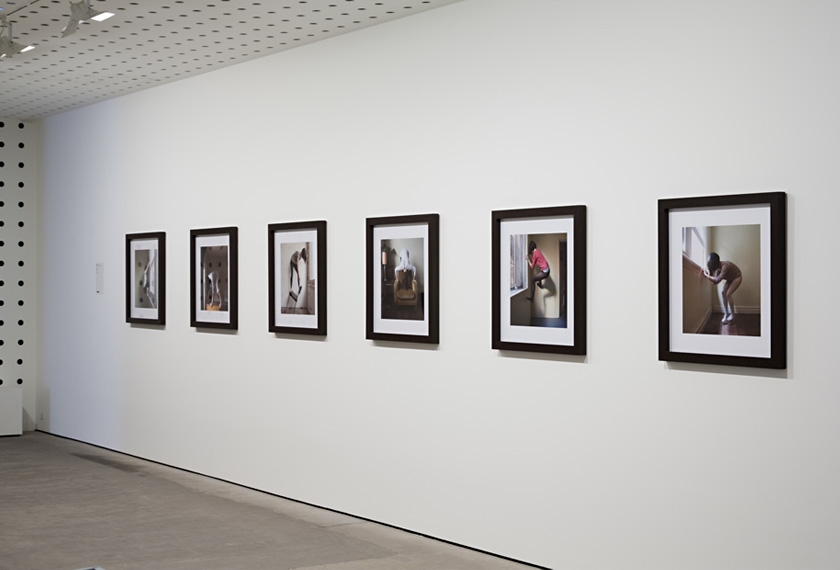
Installation view: CCP Colour Factory Award, CCP, 2009.
-

Installation view: Autumn Masterpieces: Highlights From the Permanent Collection, CCP, 2010.
-

Installation view: Kodak Salon, CCP, 2010.
-

Installation view: The Mourners, CCP, 2011.
-
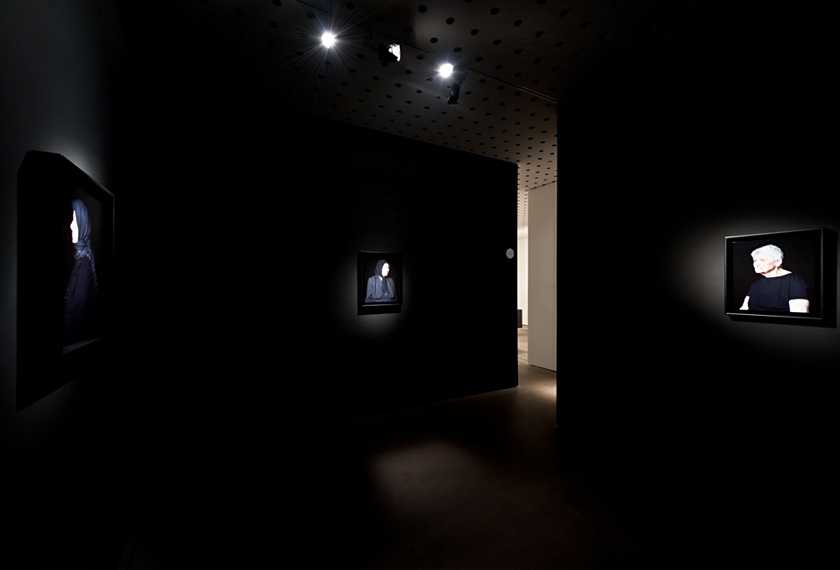
Installation view: The Mourners, CCP, 2011.
-
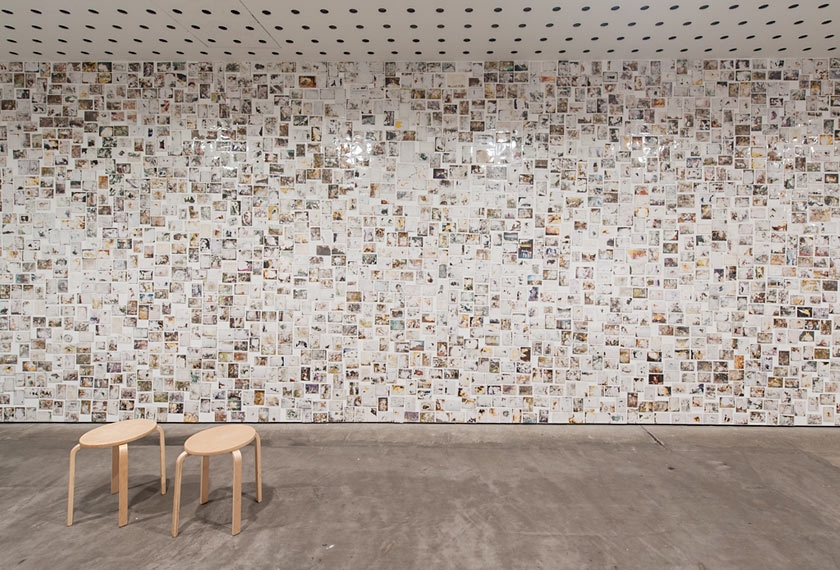
Installation view: Lost and Found, CCP, 2012.
-
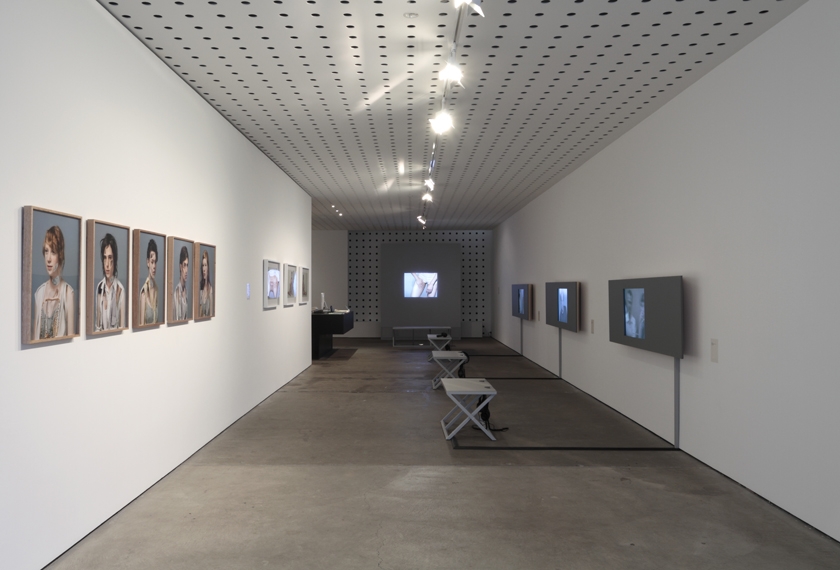
Installation view: True Self: David Rosetzky Selected Works, CCP, 2011.
-
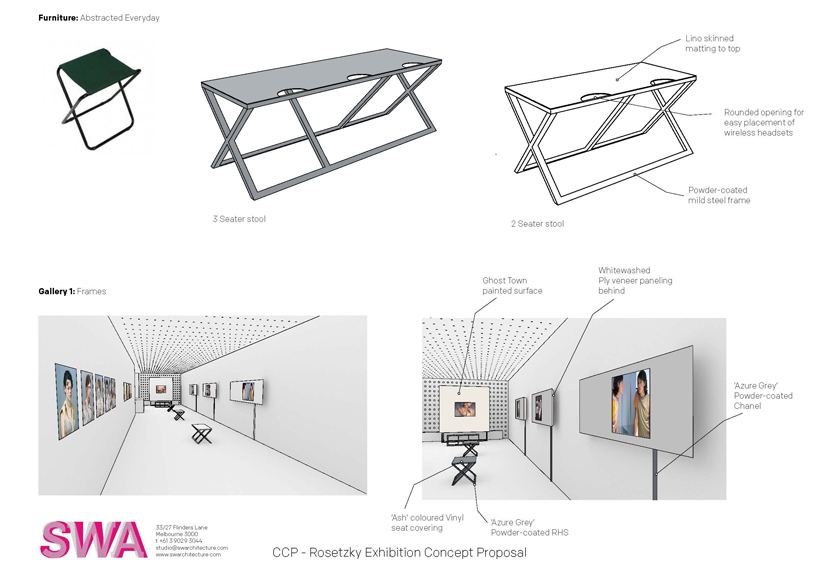
Architect's drawings
Many variables influence the design of an exhibition such as the rationale of the work; the scale of the gallery space; the budget; time available to install the exhibition; safety and security issues and the audience.
Exhibitions presented at CCP are varied and can include visual and/or sound installations, two and/or three dimensional artwork, time-based artworks, work drawn, painted or projected onto walls, and performance.
The placement of artworks can have an impact on the way audiences view them. A carefully considered arrangement of artworks encourages the viewer to make conceptual leaps between works of art and to create a sense of visual prominence for key works.
The process of transforming bare white walls into an exhibition environment prompts a thorough consideration of the potential relationships between individual pieces.
Devices such as the colour of the walls, style of lighting and methods for hanging artworks all contribute to the appearance and mood of an exhibition.
Some exhibitions are actually devised by artists as a series of components that are then transported and assembled for the first time on site at the gallery.
Exhibiting artists and/or curators are responsible for the overall design and layout of exhibitions at CCP. In this role they act as mediators between the artworks and the viewer.
Display of Artwork, Case Study 1
Lost and Found: Family Photos Swept Away by the 3.11 East Japan Tsunami (2012)
Presented as a visual sea of images each picture is displayed in close proximity to the next. The images are the collected remnants of family photographs recovered from the devastation following the tsunami in Japan in 2011. While visually effective, this exhibition is highly unusual for CCP as it is not the work of contemporary photographic artists. By presenting these damaged family photographs together in this way, the viewer is given an opportunity to reflect upon the scale of the disaster and the profound impact of this event on families in Japan. Due to the fragile nature of these photographs and their memorial significance, each photograph was placed in a clear Mylar sleeve and archival Blu Tack used to attach them to the gallery wall.
Display of Artwork, Case study 2
John Nixon, Black White and Grey. Photographic Studies (Photosheets) (2012)
For this exhibition John Nixon used cream-coloured foolscap manila folders as a framing device for his photographs. By using business stationery, traditionally used for filing documents, as a format to organise and present the artwork, Nixon emphasises the manual ‘cut and paste’ method he used to lay out and group his images. Pinning folders to the gallery wall was a very efficient way for the artist to install and de-install the exhibition.
Display of Artwork, Case Study 3
Poklong Anading, Anonymity (2011)
This work consisted of 12 cardboard light-boxes, each containing a single portrait, stacked together and installed in a corner of the gallery. For this series, individuals posed holding a circular mirror in front of their faces, reflecting the blinding glare of the sun directly into the camera lens. The heads of these subjects disappear in reflected light so that their clothes and the objects that surround them become the only signs of their identity. The light-boxes emphasised the extraordinary play of light within the images. They were complex to install due to the numerous electrical connections that needed to be hidden from view.
For more exhibition examples, visit the CCP website.
Display of Artwork, Case Study 4
True Self: David Rosetzky Selected Works (2013)
Architect Simon Whibley was invited to solve a particular problem faced by CCP and many galleries in exhibiting multiple video works that include sound, for display in one sonic (sound) space. Sound bleed is one of the hurdles in presenting multiple video works. A further challenge for the architect was to solve this in a manner consistent with the artist's highly refined aesthetic. The architect was also constrained by time and budget.
Simon Whibley's specific commission was to create a series of small spatial environments, namely exhibition furniture, that could house video works and seating for viewers to watch time based works. The design brief encompassed practical aspects, such as concealing technology and framing different screen ratios of video artworks, but also aesthetic considerations around creating a unified viewing space that could assist and enhance people’s engagement with the artworks. Another facet of the project involved finding the best way to support the presentation of the artworks across a range of diverse touring venues across regional Australia, because each venue will present completely different viewing conditions.
The project required great sensitivity in order to avoid inserting an architectural dialogue into Rosetzky’s exhibition. Rosetzky’s artwork Think of Yourself as Plural was the starting point for developing the design concepts. Colours and fabrics in this work provided a basis for the colour palette and junctions between the various textures and materials- plywood, paint and linoleum. Rosetzky’s composition of everyday objects also became a source of inspiration for the architect. For example, the seating is based on camping seats- a re-design and re-purposing of something well known rather than the invention of something new.
Another aspect of the exhibition design involved considering how each of the exhibition elements could be easily assembled, disassembled, packed and freighted to different locations. The architect collaborated closely with the organisation National Exhibitions Touring Support (NETS), CCP curators, the fabricator and the CCP installation crew to work out how each component fitted together and how they could be tough enough to withstand two years of moving around Australia.
-

Handling artwork during the installation of Kodak Salon, CCP, 2011.
-
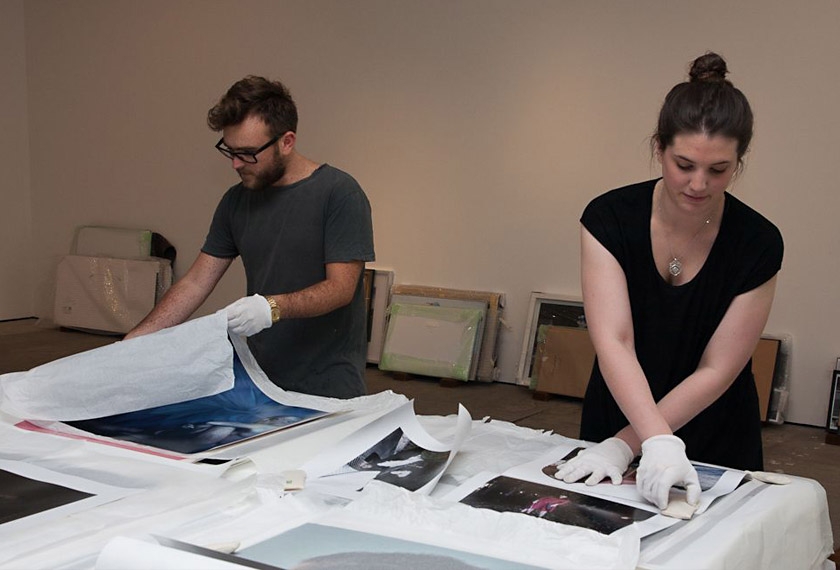
Handling artwork during the installation of Kodak Salon, CCP, 2011.
-
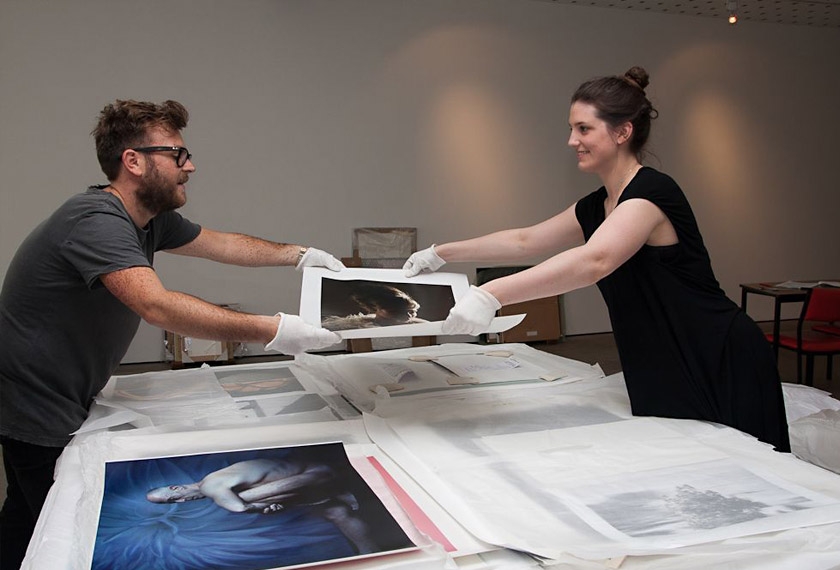
Handling artwork during the installation of Kodak Salon, CCP, 2011.
-

Kodak Salon entries stored on padded chochs waiting to be installed, CCP, 2011.
-
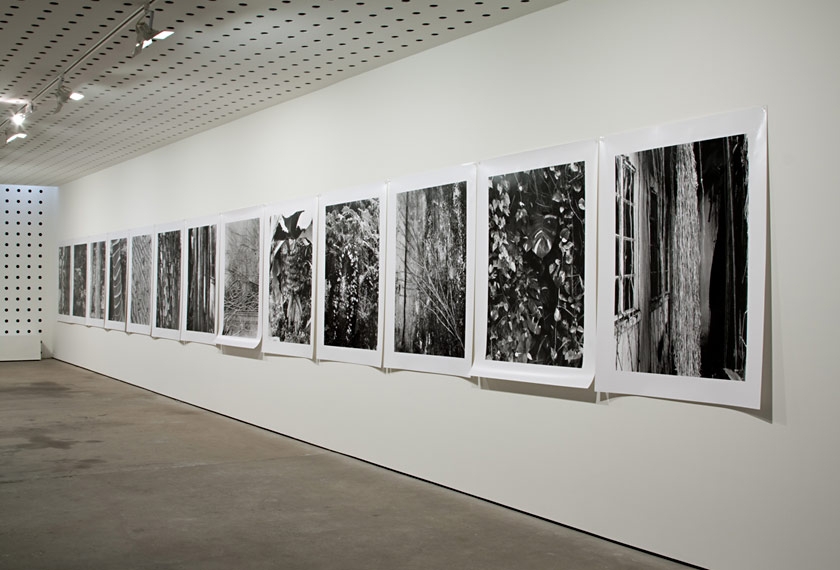
Installation view: Inland, CCP, 2009. Artworks are pinned directly to the gallery wall.
-
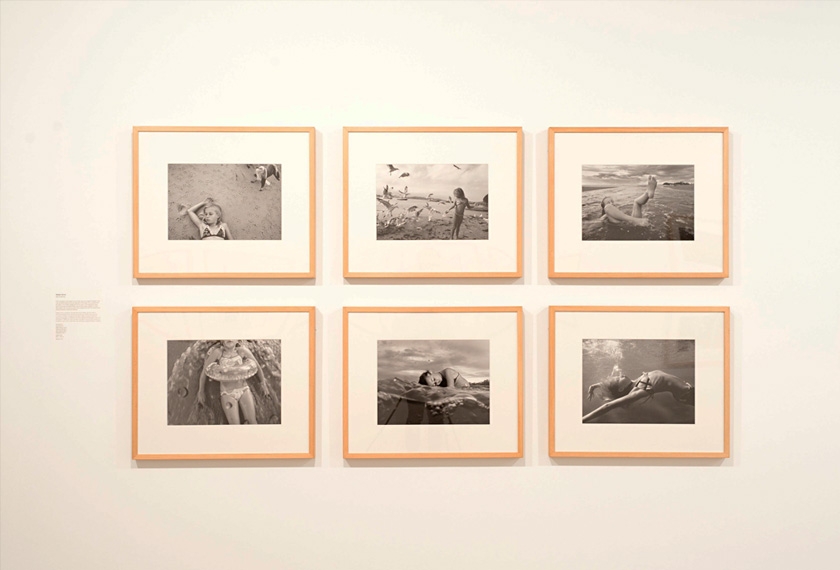
Installation view: CCP Documentary Photography Award, CCP, 2011. Artworks are framed in the traditional manner.
-
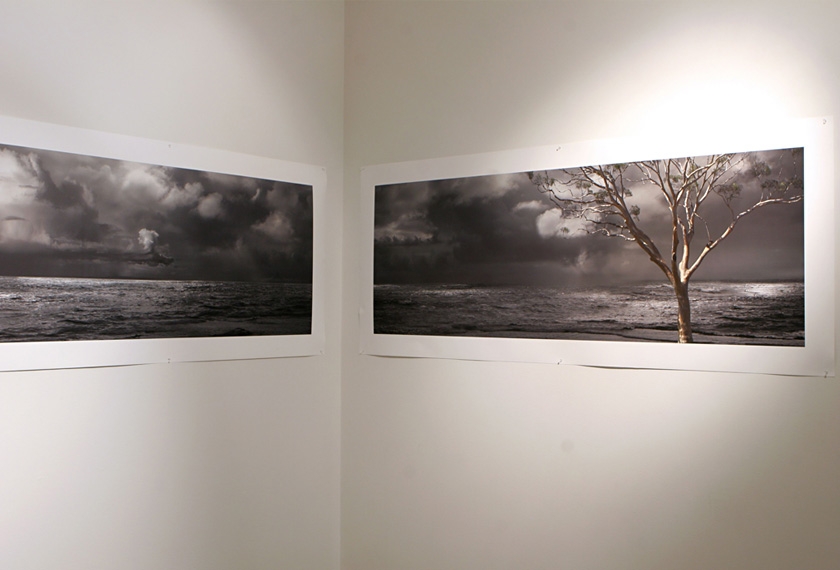
Installation view: This Weather, CCP, 2011. Artworks are pinned directly to the wall.
-
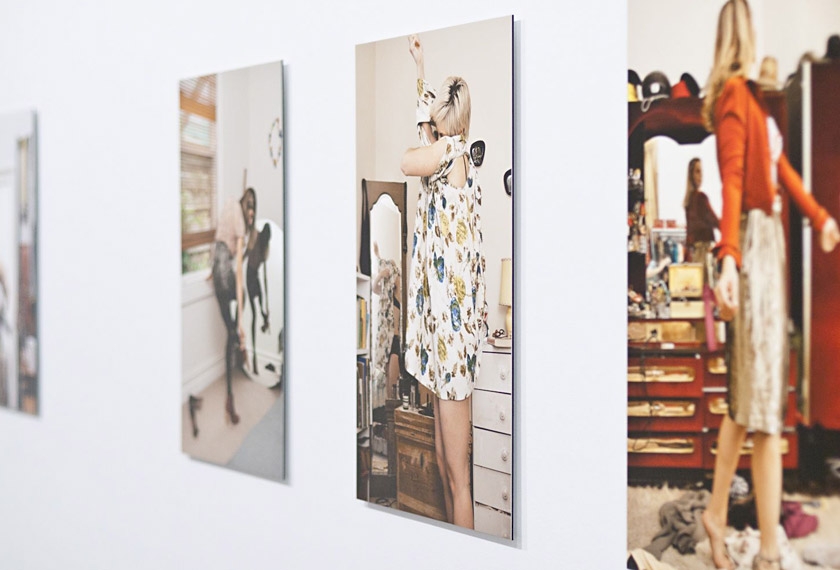
Installation view: La Toilette D'Une Femme, CCP, 2011. Photographic prints are mounted on diabond.
-

Installation view: Event Horizon, CCP, 2010. Artworks are pinned directly to the gallery wall.
Art handling
All materials used by artists contain a level of ‘inherent vice’. This inbuilt tendency towards decomposition means individual artworks must be cared for and handled in particular ways. In general, conservation and preservation of artwork encompasses two main considerations:
Materials – A specialist knowledge of the particular materials in an artwork and a concern for the decay of these types of materials over time.
Ethics – An acknowledgement and respect for the integrity of the artwork, and keeping true to the artist’s intentions for the display of that artwork.
As contemporary art can involve experimental materials that are fragile or ephemeral, curators need to be able to select and apply a range of different measures when they are storing and handling, presenting, and lighting artworks for an exhibition.
Ironically the most effective way to maintain the life of an artwork is to minimise its handling, and store it in the dark, under optimum environmental conditions. However, a balance is naturally required between conservation and public access.
Environmental hazards
Major public galleries such as the NGV employ museum-standard environmental conditions, storage and handling procedures to prevent and reduce damage, and to restore, their collection.
Some key environmental principles are:
Temperature and humidity – A climate control system regulates the temperature and moisture levels in the air, reducing the expansion and contraction of materials within artworks over time. An ideal temperature range for storing artworks is between 18 and 22 degrees Celsius.
Lighting levels – Exposure to strong light will deteriorate most artworks. The level of light used for works on paper is usually 50-150 Lux, with 200 Lux for oil paintings.
Storage – When artworks are not on display they are held in storage, generally according to museum standards. For instance, works on paper are stored flat, between archival grade tissue paper, in pH neutral, light-, dust- and pest-proof solander boxes.
Invigilation – Museums employ guards or invigilators to monitor visitors and to ensure that they do not touch works of art. Touching can transfer invisible oils onto the artwork and can cause chemical damage. Often valuable artworks are displayed behind glass for protection.
Handling – Gallery staff who handle artworks wear white gloves and handle each individual artwork with a great deal of care.
Remedial conservation and restoration work – Highly trained specialist conservators can treat an artwork if it is damaged or is deteriorating significantly. Cleaning is the most common treatment.
Digital art
A challenging and relatively new area of conservation and storage concerns the highly popular time-based art form – video. Video presents challenges as technology changes rapidly and original equipment can often not be maintained in working order over time.
Institutions all over the world are looking at solutions for this vexing issue, often preferring to migrate work to digital formats. Museums are working in consultation with living artists to ensure that their intentions are understood well into the future. For example, some artists might prefer their work to become obsolete.
For more information on conservation and preservation, visit a discussion paper on the Tate Museum’s website.
CCP: Photography Conservation in Practice
The CCP only maintains a temporary (as opposed to permanent) collection and cares for artworks for the period of time that they are being handled and are on display.
At the CCP, artwork is exhibited for around eight weeks. The CCP does not have a space to store artwork on-site prior to or after exhibition, and short exhibitions do not need museum-standard climate controls.
Artwork conservation at the CCP begins with a preliminary discussion between the curator and the exhibiting artist about the nature of the artwork and their ideas on presenting the artwork.
Curators offer advice to the artist, but do not advocate traditional conservation practices unless they align with the artist’s intention. Unlike museums in the contemporary art world, communicating the meaning of the work for the time it is on display is more important than the longevity of the work.
Mounting
The museum standard for presenting photography is to mount the print on acid-free board and then frame it behind glass.
Pinning
It is important to understand that how an artist displays their work is part of the meaning of the work. Pinning work directly to the wall is often preferred for aesthetic reasons, as it emphasises the ‘object-ness’ of the photograph—the viewer can appreciate the paper stock and its weight, providing a more direct experience.
Contemporary artists exhibiting at the CCP regularly opt to pin their artworks directly to the gallery wall. This simple technique puts a small hole into the corners of the print and can result in the print warping and buckling over time. This can be minimised when the corners are reinforced underneath.
Diabond
A popular method for mounting large prints is to bond them to an aluminium composite material known as diabond. This commercial process ensures artwork remains flat while on display, but is not good for conservation as it produces a non-reversible bond to a relatively unstable compound.
Other Methods
Occasionally unorthodox materials are used to attach artwork to the gallery walls. In the case of the exhibition Lost and Found an archival Blu Tack and clear Mylar sleeves were used.
The CCP approach
All artworks at the CCP are handled using museum standards, including use of white gloves at all times when moving artworks and following artists’ and curators’ instructions about lifting and installing individual pieces. Artworks borrowed from other galleries arrive and leave with a detailed condition report prepared by the curator.
When moving an un-framed or un-mounted print, it is preferable to roll the work and carry the roll underneath with gloved hands, or in a tube. If the work is large and unrolled, two people must lift it from two alternate corners, on the diagonal.
If a print bends or cockles (wrinkles), this cannot be reversed or repaired. For this reason, many photographic artists have an ‘exhibition set’ of prints, separate to the ‘edition set’, which can be replaced when damaged.
Prints that have travelled (rolled) in a tube must be ‘relaxed’ before being installed; this can be done by placing the artwork on a clean, flat surface to unroll naturally, or by having small, soft weights placed on each corner to encourage flatness.
Occasionally a print will be pinned to the wall at the two top corners and left overnight to unfurl before being pinned at the bottom.
For more information about artwork preservation and conservation, visit Conservation OnLine
-
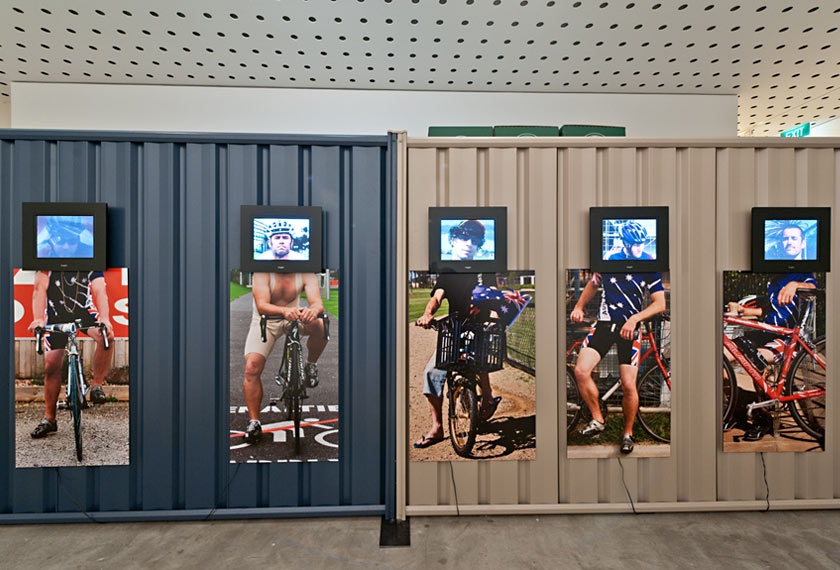
Installation view: Australia Days, CCP, 2011.
-
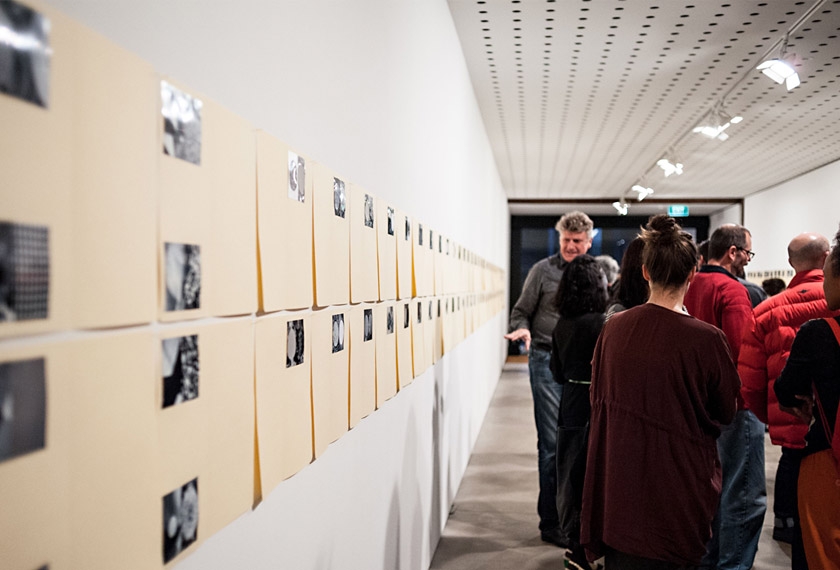
Opening night: Black White & Grey. Photographic Studies (Photosheets), CCP, 2012.
-
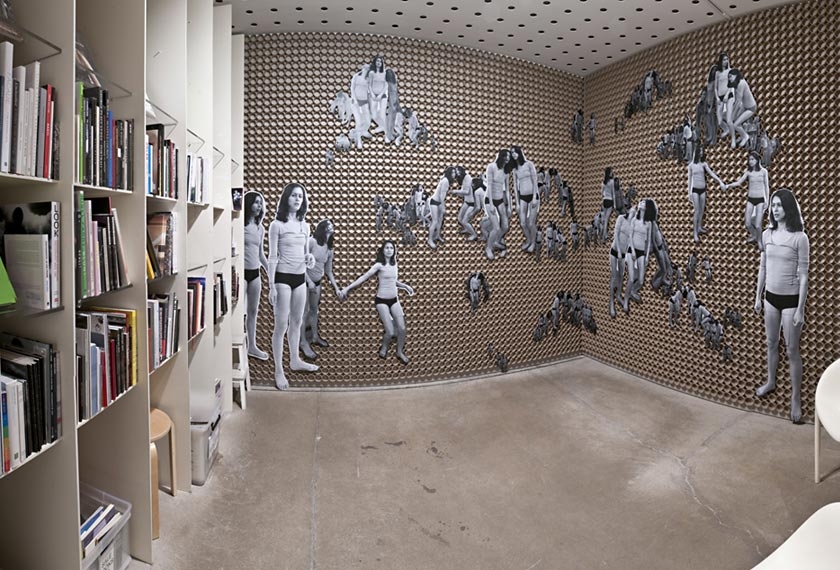
Installation view: Installed in the Midst of the Visible, CCP, 2011.
-
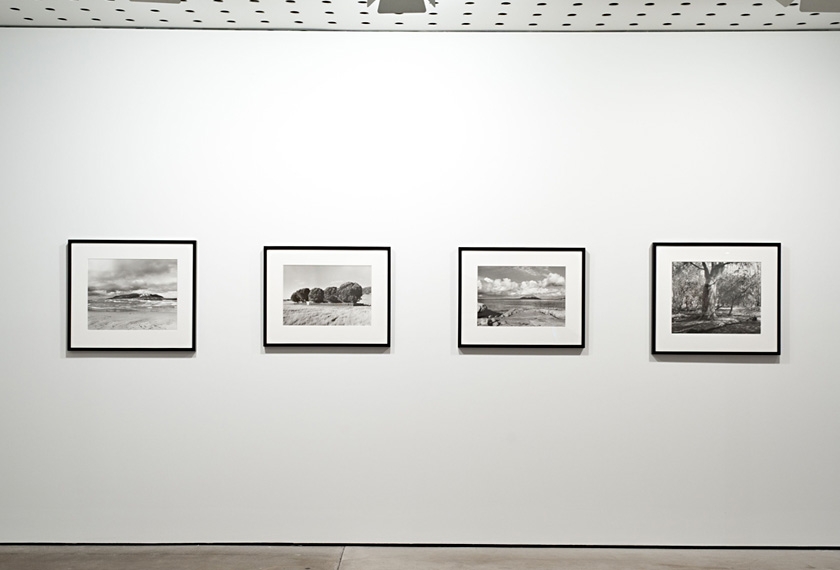
Installation view: Without Words, CCP, 2011.
-
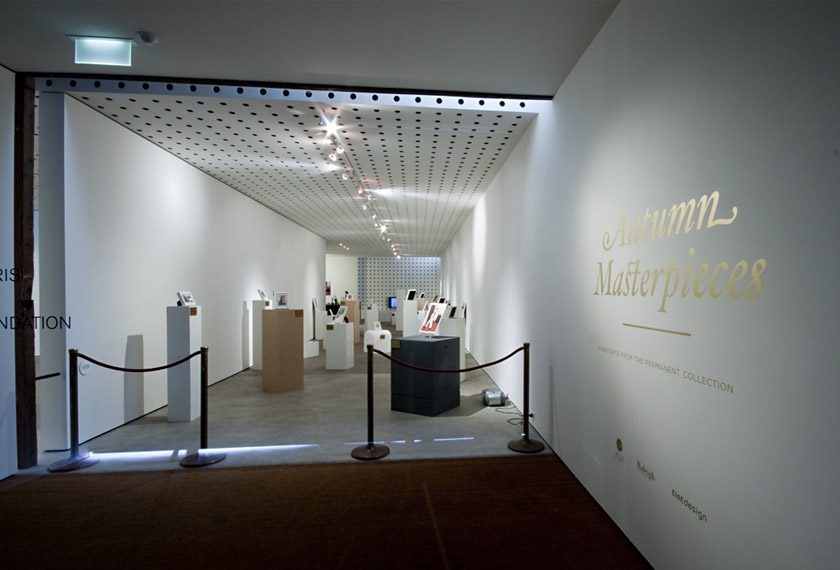
Installation view: Autumn Masterpieces, CCP, 2010.
Introduction
Developing an art exhibition involves a series of considered selections by artists and gallery staff. This process begins when the artist prepares an exhibition proposal or comes to the attention of an art industry professional such as a curator.
Selection
Contemporary art spaces achieve a critical role in the ‘ecology’ of the visual arts, through creating an opportunity for the presentation of new, challenging or experimental ideas.
Selecting which artists will exhibit at a contemporary art gallery such as CCP is an intensive process. It often requires consideration to the formation and selection of ideas that artists and curators believe will make a lasting contribution to Australian culture.
At CCP, an advisory panel of up to eight experts discusses, argues and selects what the gallery will exhibit. The advisory panel aims to choose artists who will make a lasting impression on audiences as well as making a tangible contribution to the area of contemporary photomedia.
Process
Once selected, an artist will usually visit the gallery to measure the space/s they have been assigned. They then prepare their artwork with the architecture of the gallery space in mind.
Artists and curators consider the space as a total environment, integral to the meaning and effectiveness of the exhibition.
Artists may therefore alter the existing architecture of the gallery. For instance they may cut a hole in the floor or wall, install carpet or paint the walls.
Exhibition Program
Each year CCP staff crafts a final exhibition program based on the selected exhibitions. Below is a list of past exhibition types:
Curated exhibitions such as Kyla McFarlane’s Without Words (2011) , Mark Feary’s Event Horizon (2010) and Naomi Cass's In camera and in public (2011). These are initiated and developed by the CCP curators to explore particular themes or ideas. Curators determine the artworks they would like to group together and negotiate with artists, owners and commercial galleries to borrow the works. They work within a budget to design the exhibition and possibly alter the gallery space to present the artworks. They usually write a catalogue essay about the central ideas within the exhibition.
Proposal exhibitions such as Sharon Billinge’s Installed in the Midst of the Visible and Sarah Ryan’s The Fourth Dimension (both 2011). These exhibitions arise from a successful proposal to the gallery. Artists are responsible for installing and de-installing the exhibition. If an artist paints or alters the environment for their exhibition, they are required to undertake restoration afterwards.
Solo exhibitions such as Georgia Metaxas’s The Mourners (2011) and John Nixon’s Black White and Grey: Photographic Studies (Photosheets) (2012). These exhibitions are presented by a single artist.
Group exhibitions such as Photocopier (2010) are exhibitions presented by several artists who wish to share the gallery environment and collaborate on an exhibition.
Award exhibitions such as the CCP Documentary Photography Award. Photographers submit their work for inclusion in the exhibition and are selected by eminent judges from the photographic and arts community. The judges also select an overall winner.
Touring exhibitions such as Taryn Simon’s An American Index of the Hidden and Unfamiliar (2010). These exhibitions travel to and from other Australian and international galleries.
Community engagement exhibitions such as Kodak Salon. This annual event at the CCP is sponsored by Kodak. It offers the professional photographic community, students and enthusiasts the opportunity to exhibit their work at CCP. There are usually around 400 photographs on display during this popular exhibition.
Fundraising exhibitions such as Limited Edition Print (LEP). Each year an established and highly regarded photographic artist such as Bill Henson or Patricia Piccinini generously offers to donate ten copies of one of their artworks to CCP as its major fundraiser. The prints are offered for sale to CCP patrons and art collectors.
To view more past exhibition examples, visit the CCP website.
-
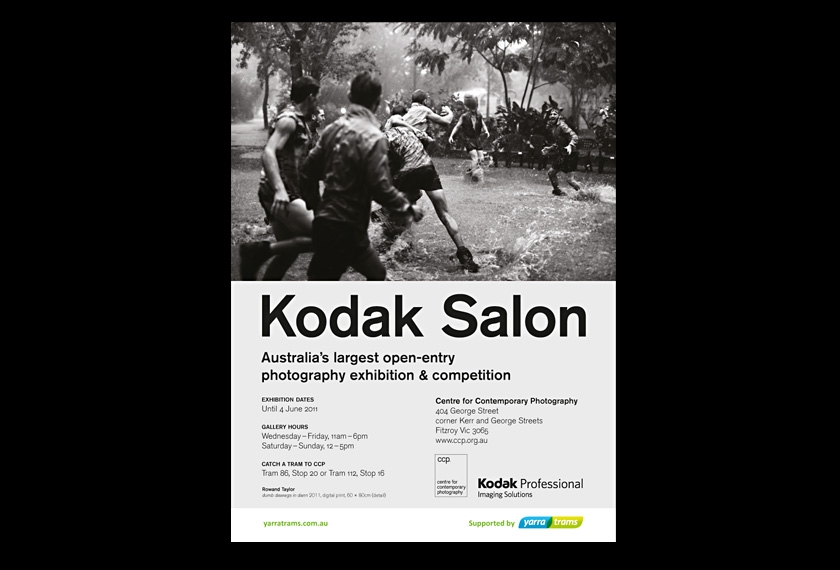
Kodak Salon 2011 Promotional Poster.
-
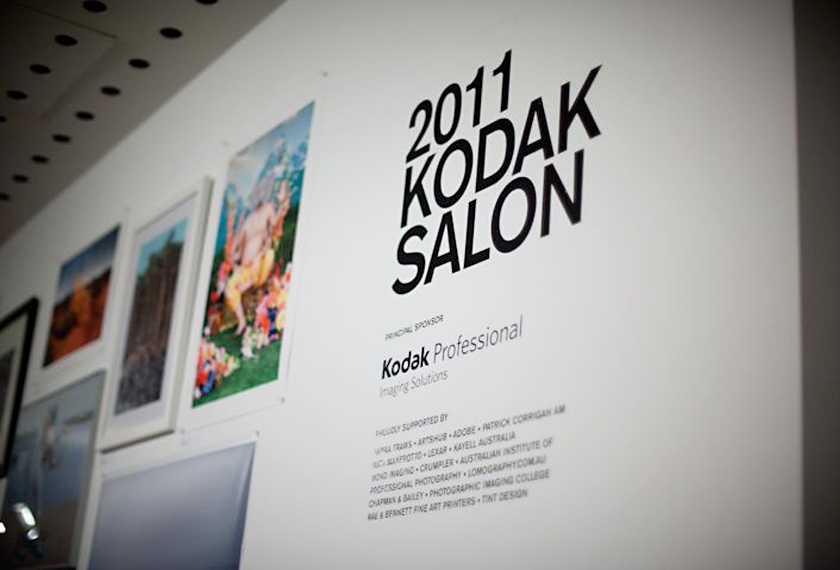
Kodak Salon 2011 Wall Text.
-
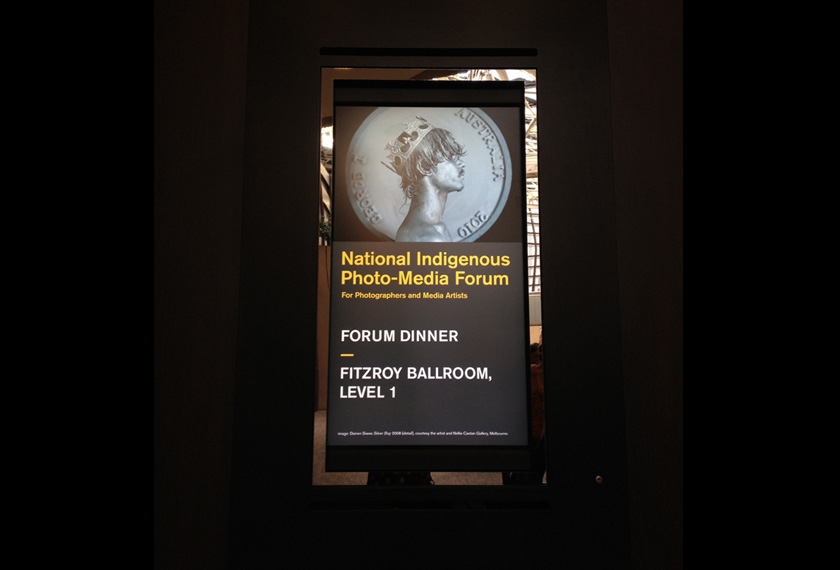
National Indigenous Photo-Media Forum Lightbox Display.
-

Exterior view: Night Projection Window, Centre for Contemporary Photography.
-
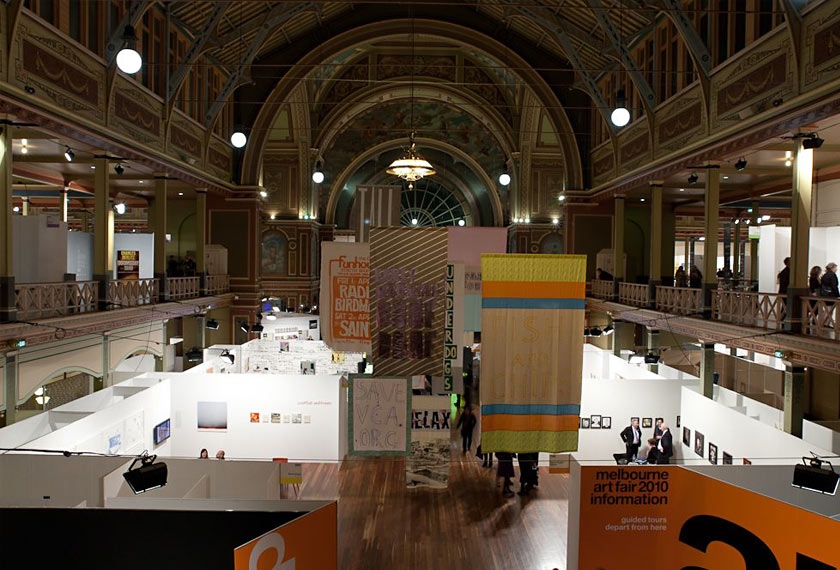
Installation view: Melbourne Art Fair, Royal Exhibition Building, 2010.
Introduction
Promoting and marketing are useful ways for an arts organisation to establish, maintain and build a public profile.
As a not-for-profit organisation, CCP has a modest marketing budget for public engagement.
Their marketing strategies are designed to connect with the public in order to inspire them to see an exhibition, enrol for an education program, attend an event or even participate as a volunteer, member, patron or exhibiting artist.
Word-of-mouth
Their most effective form of marketing is word-of-mouth or social media, arising from a great exhibition, lecture, workshop or public program. CCP’s only regular advertising is listings in the Art Guide and Art Almanac and sometimes in the online community site ArtsHub.
Press releases
CCP’s curators strive to generate free publicity for the gallery through press releases to newspapers. Print media is invaluable for the gallery in reaching a broader audience.
Festival partners
Free publicity often arises when CCP exhibitions are affiliated with large festivals such as Next Wave and the Melbourne Festival, or when CCP participates in off-site events such as the Melbourne Art Fair.
In-tram promotion
A further form of free publicity is granted to CCP on application, when Yarra Trams promote CCP’s Kodak Salon through in-tram promotional posters.
Facebook community
CCP has about 8,000 email subscribers who receive invitations to exhibitions openings. CCP has also created an online presence on Facebook with approximately 5,500 members. This has been a successful way for the gallery to connect with people both local and abroad.
One effective tactic has been to ask our Facebook members to tag people in an opening night photograph. These photographs provide attendees at these events with a record of themselves and their friends that can be shared, and which is conducive to viral promotion.
‘Like’ CCP’s Facebook page now.
Twitter account
Twitter is another form of social media being used to promote CCP, with tweets such as ‘Don’t miss this Saturday’s artists talks’ used to generate interest.
Follow CCP on twitter now.
Design
CCP employs an in-house graphic designer who ensures that all forms of marketing and promotion undertaken at the CCP are professional, clear and effective. CCP’s graphic identity is carefully considered and maintained.
Window promotion
CCP’s Night Projection Window, while presenting one of the country’s longest standing and effective night projection screens for contemporary art, is also an effective way of promoting CCP to a broader audience.
Every night, a temporary video artwork or slide show can be viewed on CCP’s George Street window, giving locals and visitors to the Fitzroy precinct a taste of what they may see if they come inside the gallery during opening hours.
Learning activity for the classroom
Inspired by Charlie Sofo's video, spots
Create your own artwork by carefully observing and recording the details of your neighbourhood or your daily journey to and from school using any lens based media. You might try different times of day or night, playing with the change in natural light. You might also choose to focus on small incidental details rather than the full scene. Select and edit your collection of images to produce a finished artwork about your experience. For instance, you may produce a time-based artwork like Charlie Sofo or you may produce a sequence of still images. Consider how to you might present your artwork in a class exhibition.
View video here
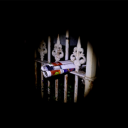
The following Art Industry sample questions have been designed for Studio Arts teachers and students to consider in response to FAST gallery visits and online resources.



